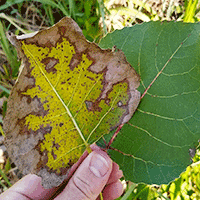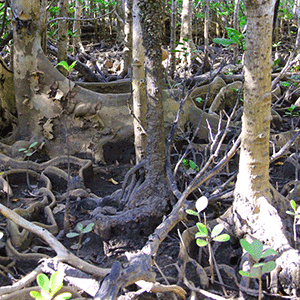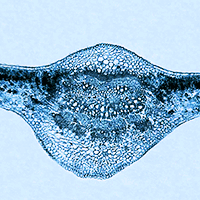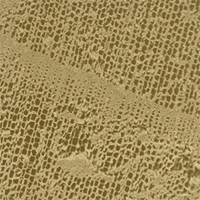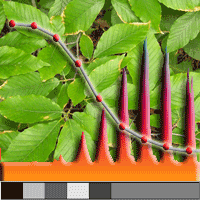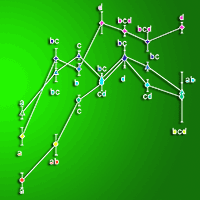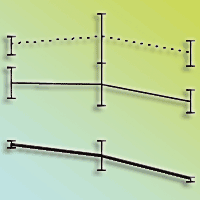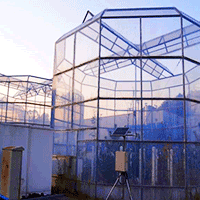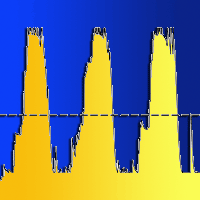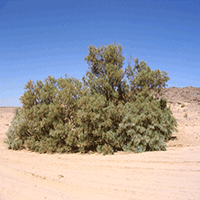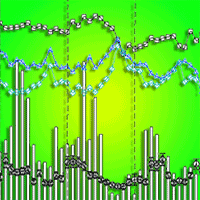Salt stress poses a challenge to tree species in regions where salinity occurs intermittently. Poplars (Populus spp.) are key species for forestry, yet their responses to salt stress remain underexplored, particularly within the intra-specific variability of Populus deltoides W.Bartram ex Marshall. This study investigates the sodium accumulation strategies of two P. deltoides clones, ’Australiano 129/60’ (A129) and ’Hovyú INTA’ (HOV), to understand their contrasting responses to low salinity levels that affect growth and development. A field trial was conducted in monoclonal and mixed clonal plantations established in 2017. Soil and water table salinity were monitored, and sodium concentrations were measured in the roots, branches, and leaves. Growth traits, including height and diameter, were analyzed in relation to sodium distribution in plant tissues. Results revealed that both clones absorbed sodium at similar rates in their roots; however, their sodium transport mechanisms diverged in the aboveground tissues. A129 avoided sodium accumulation in leaves, likely through mechanisms of exclusion at the xylem level, minimizing ion toxicity and preserving leaf functionality. In contrast, HOV accumulated higher sodium levels in leaves, correlating with visible damage, reduced growth, and a negative impact on diameter increment. The findings demonstrate that even under low salinity conditions, the intra-specific variability of P. deltoides plays a crucial role in determining growth outcomes. A129’s ability to limit sodium accumulation in leaves offers an adaptive advantage, although it does not classify this clone as highly salt-tolerant. This study provides valuable insights into the sodium dynamics of poplar clones, contributing to the selection of suitable genotypes for forestry practices in regions with moderate salinity challenges. Future research should address the role of other ions, such as chloride, and further characterize the exclusion mechanisms employed by A129 to enhance understanding of salinity responses in P. deltoides.
Keywords
, , ,
Citation
Bonnin SM, Alvarez JA, Faustino LI, Graciano C (2025). Two Populus deltoides W.Bartram ex Marshall clones cope differentially with sodium salinity stress. iForest 18: 259-266. - doi: 10.3832/ifor4783-018
Academic Editor
Werther Guidi Nissim
Paper history
Received: Dec 30, 2024
Accepted: May 03, 2025
First online: Oct 10, 2025
Publication Date: Oct 31, 2025
Publication Time: 5.33 months
© SISEF - The Italian Society of Silviculture and Forest Ecology 2025
Open Access
This article is distributed under the terms of the Creative Commons Attribution-Non Commercial 4.0 International (https://creativecommons.org/licenses/by-nc/4.0/), which permits unrestricted use, distribution, and reproduction in any medium, provided you give appropriate credit to the original author(s) and the source, provide a link to the Creative Commons license, and indicate if changes were made.

Breakdown by View Type
(Waiting for server response...)
Article Usage
Total Article Views: 1108
(from publication date up to now)
Breakdown by View Type
HTML Page Views: 357
Abstract Page Views: 414
PDF Downloads: 306
Citation/Reference Downloads: 0
XML Downloads: 31
Web Metrics
Days since publication: 49
Overall contacts: 1108
Avg. contacts per week: 158.29
Article Citations
Article citations are based on data periodically collected from the Clarivate Web of Science web site
(last update: Mar 2025)
(No citations were found up to date. Please come back later)
Publication Metrics
by Dimensions ©
Articles citing this article
List of the papers citing this article based on CrossRef Cited-by.
(1)
Ali R, Elliott RL, Ayars JE, Stevens EW (2000)Soil salinity modeling over shallow water tables. II: Application of LEACHC. Journal of Irrigation and Drainage Engineering 126: 234-242.
CrossRef |
Gscholar
(2)
Andrade JM, Estévez-Pérez MG (2014)Statistical comparison of the slopes of two regression lines: a tutorial. Analytica Chimica Acta 838: 1-12.
CrossRef |
Gscholar
(3)
Bekele A, Hudnall WH, Daigle JJ, Prudente JA, Wolcott M (2005)Scale-dependent variability of soil electrical conductivity by indirect measures of soil properties. Journal of Terramechanics 42: 339-351.
CrossRef |
Gscholar
(4)
Beritognolo I, Piazzai M, Benucci S, Kuzminsky E, Sabatti M, Scarascia Mugnozza G, Muleo R (2007)Functional characterisation of three Italian
Populus alba L. genotypes under salinity stress. Trees - Structure and Function 21: 465-477.
CrossRef |
Gscholar
(5)
Bilek MA, Soolanayakanahally RY, Guy RD, Mansfield SD (2020)Physiological response of
Populus balsamifera and
Salix eriocephala to salinity and hydraulic fracturing wastewater: potential for phytoremediation applications. International Journal of Environmental Research and Public Health 17: 7641.
CrossRef |
Gscholar
(6)
Bremner JM (1996)Nitrogen - Total. In: “Methods of Soil Analysis - Part 3. Chemical Methods” (Sparks SL, Page AL, Helmke PA, Loeppert RH, Soltanpour PN, Tabaitabai MA, Johnston CT, Sumner ME eds). Soil Science Society of America, Madison, Wisconsin, USA.
CrossRef |
Gscholar
(7)
Cataldi TRI, Margiotta G, Del Fiore A, Bufo SA (2003)Ionic content in plant extracts determined by ion chromatography with conductivity detection. Phytochemical Analysis 14: 176-183.
CrossRef |
Gscholar
(8)
Chen S, Li J, Fritz E, Wang S, Hüttermann A (2002)Sodium and chloride distribution in roots and transport in three poplar genotypes under increasing NaCl stress. Forest Ecology and Management 168: 217-230.
CrossRef |
Gscholar
(9)
Chen S, Li J, Wang S, Fritz E, Hüttermann A, Altman A (2003)Effects of NaCl on shoot growth, transpiration, ion compartmentation, and transport in regenerated plants of
Populus euphratica and
Populus tomentosa. Canadian Journal of Forest Research 33: 967-975.
CrossRef |
Gscholar
(10)
Chen S, Polle A (2010)Salinity tolerance of
Populus. Plant Biology 12: 317-333.
CrossRef |
Gscholar
(11)
Della Maggiora L, Francini A, Giovannelli A, Sebastiani L (2023)Assessment of the salinity tolerance, response mechanisms, and nutritional imbalance to heterogeneous salt supply in
Populus alba L. clone ’Marte’ using a split-root system. Plant Growth Regulation 101: 251-265.
CrossRef |
Gscholar
(12)
Diaz E, Boschetti N, Quintero C, Duarte O, Carñel G, Pujato E (2013)Variabilidad 3d de las aguas subterráneas en el Delta del Río Paraná. Argentina [3d groundwater variability in the Delta del Río Paraná. Argentina]. In: “Temas Actuales de la Hidrología Subterránea” (Gonzalez N, Kruse E, Trovatto MM, Laurencena P eds). EDULP, Editorial de la Universidad de La Plata, La Plata, Argentina. [in Spanish]
Online |
Gscholar
(13)
Dillen SY, Rood SB, Ceulemans R (2010)Genetics and genomics of
Populus. In: “Plant Genetics and Genomics: Crops and Models” (Jansson S, Bhalerao R, Groover A eds). Springer Science and Business Media BV, New York, USA.
CrossRef |
Gscholar
(14)
Ding M, Hou P, Shen X, Wang M, Deng S, Sun J, Xiao F, Wang R, Zhou X, Lu C, Zhang D, Zheng X, Hu Z, Chen S (2010)Salt-induced expression of genes related to Na
+/K
+ and ROS homeostasis in leaves of salt-resistant and salt-sensitive poplar species. Plant Molecular Biology 73: 251-269.
CrossRef |
Gscholar
(15)
Farrell C, Szota C, Hobbs RJ, Colmer TD (2011)Microsite and litter cover effects on soil conditions and seedling recruitment in a saline agricultural system. Plant and Soil 348: 397-409.
CrossRef |
Gscholar
(16)
Foster KJ, Miklavcic SJ (2015)Toward a biophysical understanding of the salt stress response of individual plant cells. Journal of Theoretical Biology 385: 130-142.
CrossRef |
Gscholar
(17)
Foster KJ, Miklavcic SJ (2017)A comprehensive biophysical model of ion and water transport in plant roots. I. Clarifying the roles of endodermal barriers in the salt stress response. Frontiers in Plant Science 8: 1-18.
CrossRef |
Gscholar
(18)
Galović V, Kebert M, Popović BM, Kovačević B, Vasić V, Joseph MP, Orlović S, Szabados L (2021)Biochemical and gene expression analyses in different poplar clones: the selection tools for afforestation of halomorphic environments. Forests 12: 1-21.
CrossRef |
Gscholar
(19)
Godfrey JM, Ferguson L, Sanden BL, Tixier A, Sperling O, Grattan SR, Zwieniecki MA (2019)Sodium interception by xylem parenchyma and chloride recirculation in phloem may augment exclusion in the salt-tolerant
Pistacia genus: context for salinity studies on tree crops. Tree Physiology 39: 1484-1498.
CrossRef |
Gscholar
(20)
Hasegawa PM, Bressan RA, Zhu J, Bohnert HJ (2000)Plant cellular and molecular responses to high salinity. Annual Review of Plant Physiology and Plant Molecular Biology 51: 463-499.
CrossRef |
Gscholar
(21)
Herbert ER, Boon P, Burgin AJ, Neubauer SC, Franklin RB, Ardón M, Hopfensperger KN, Lamers LPM, Gell P (2015)A global perspective on wetland salinization: ecological consequences of a growing threat to freshwater wetlands. Ecosphere 6: 43.
CrossRef |
Gscholar
(22)
Hu Y, Kamelchuk D, Krygier R, Thomas BR (2021)Field testing of selected salt-tolerant screened balsam poplar (
Populus balsamifera L.) clones for use in reclamation around end-pit lakes associated with bitumen extraction in Northern Alberta. Forests 12: 572.
CrossRef |
Gscholar
(23)
Hu Z, Miao Q, Shi H, Feng W, Hou C, Yu C, Mu Y (2023)Spatial variations and distribution patterns of soil salinity at the canal scale in the Hetao Irrigation District. Water 15: 3342.
CrossRef |
Gscholar
(24)
Imada S, Yamanaka N, Tamai S (2009)Effects of salinity on the growth, Na partitioning, and Na dynamics of a salt-tolerant tree,
Populus alba L. Journal of Arid Environments 73: 245-251.
CrossRef |
Gscholar
(25)
Isla R, Guillén M, Aragüés R (2014)Response of five tree species to salinity and waterlogging: shoot and root biomass and relationships with leaf and root ion concentrations. Agroforestry Systems 88: 461-477.
CrossRef |
Gscholar
(26)
Jobbágy EG, Jackson RB (2004)Groundwater use and salinization with grassland afforestation. Global Change Biology 10: 1299-1312.
CrossRef |
Gscholar
(27)
Li S, Wu M, Jia Z, Luo W, Fei L, Li J (2021)Influence of different controlled drainage strategies on the water and salt environment of ditch wetland: A model-based study. Soil and Tillage Research 208: 104894.
CrossRef |
Gscholar
(28)
Li Y, Duan B, Chen J, Korpelainen H, Niinemets U, Li C (2016)Males exhibit competitive advantages over females of
Populus deltoides under salinity stress. Tree Physiology 36: 1573-1584.
CrossRef |
Gscholar
(29)
Li Z, Peng D, Zhang X, Peng Y, Chen M, Ma X, Huang L, Yan Y (2017)Na
+ induces the tolerance to water stress in white clover associated with osmotic adjustment and aquaporins-mediated water transport and balance in root and leaf. Environmental and Experimental Botany 144: 11-24.
CrossRef |
Gscholar
(30)
Llanes A, Palchetti MV, Vilo C, Ibañez C (2021)Molecular control to salt tolerance mechanisms of woody plants: recent achievements and perspectives. Annals of Forest Science 78: 96.
CrossRef |
Gscholar
(31)
Losinno BN, Sainato CM, Giuffré L (2005)Propiedades edáficas y del agua subterránea. Riesgos de salinización y sodificación de los suelos, en la zona de Pergamino-Arrecifes. [Edaphic and groundwater properties. Risks of salinization and sodification of soils at the pergamino-arrecifes zone]. Ciencia del Suelo 23: 47-58. [in Spanish]
Online |
Gscholar
(32)
Ma Y, Cheng Q, Cheng Z, Li H, Chang Y, Lin J (2017)Identification of important physiological traits and moderators that are associated with improved salt tolerance in CBL and CIPK overexpressors through a meta-analysis. Frontiers in Plant Science 8: 246.
CrossRef |
Gscholar
(33)
Maathuis FJM, Ahmad I, Patishtan J (2014)Regulation of Na
+ fluxes in plants. Frontiers in Plant Science 5: 1-9.
CrossRef |
Gscholar
(34)
Miao L, Li D, Yang F, Tan Z (2020)Sex-specific responses of
Populus deltoides to combined salinity and calcium under waterlogging conditions. Biologia Plantarum 64: 753-763.
CrossRef |
Gscholar
(35)
Mirck J, Zalesny RS (2015)Mini-review of knowledge gaps in salt tolerance of plants applied to willows and poplars. International Journal of Phytoremediation 17: 640-650.
CrossRef |
Gscholar
(36)
Munns R, James RA, Gilliham M, Flowers TJ, Colmer TD (2016)Tissue tolerance: an essential but elusive trait for salt-tolerant crops. Functional Plant Biology 43: 1103.
CrossRef |
Gscholar
(37)
Munns R, Wallace PA, Teakle NL, Colmer TD (2010)Measuring soluble ion concentrations (Na
+, K
+, Cl
-) in salt-treated plants. In: “Plant Stress Tolerance. Methods in Molecular Biology” (Sunkar R ed). Humana Press, New Jersey, USA.
CrossRef |
Gscholar
(38)
Nelson DW, Sommers LE (1996)Total carbon, organic carbon, and organic matter. In: “Methods of Soil Analysis - Part 3 Chemical Methods” (Sparks SL, Page AL, Helmke PA, Loeppert RH, Soltanpour PN, Tabaitabai MA, Johnston CT, Sumner ME eds). Soil Science Society of America, Madison, Wisconsin, USA.
CrossRef |
Gscholar
(39)
Nosetto MD, Jobbágy EG, Tóth T, Jackson RB (2008)Regional patterns and controls of ecosystem salinization with grassland afforestation along a rainfall gradient. Global Biogeochemical Cycles 22: 1-12.
CrossRef |
Gscholar
(40)
Pereyra FP, Baumann V, Altinier V, Ferrer J, Tchilinguirian P (2004)Génesis de suelos y evolución del paisaje en el Delta del río Paraná [Soil genesis and landscape evolution in the Parana River Delta]. Revista de la Asociación Geológica Argentina 59: 229-242. [in Spanish]
Online |
Gscholar
(41)
Perez M, Guerra LD, Storniolo R, Vanzolini J, Kloster N (2019)Comparación de métodos para determinación de fósforo extraíble en suelos de la región semiárida pampeana. [Evaluation of methods for determining soil phosphorus extractable in the semiarid Pampean Region]. Ciencia del Suelo 37: 11-20. [in Spanish]
Online |
Gscholar
(42)
Qu M, Sun Q, Chen N, Chen Z, Zhang H, Lv F, An Y (2023)Functional characterization of a new salt stress response gene, PeCBL4, in
Populus euphratica Oliv. Forests 14: 1504.
CrossRef |
Gscholar
(43)
Rhoades JD (1996)Salinity: electrical conductivity and total dissolved solids. In: “Methods of Soil Analysis - Part 3 Chemical Methods” (Sparks SL, Page AL, Helmke PA, Loeppert RH, Soltanpour PN, Tabaitabai MA, Johnston CT, Sumner ME eds). Soil Science Society of America, Madison, Wisconsin, USA.
CrossRef |
Gscholar
(44)
Schollenberger CJ, Simon RH (1945)Determination of exchange capacity and exchangeable bases in soil. Ammonium acetate method. Soil Science 59: 13-24.
CrossRef |
Gscholar
(45)
Seeboonruang U (2013)Relationship between groundwater properties and soil salinity at the Lower Nam Kam River Basin in Thailand. Environmental Earth Sciences 69: 1803-1812.
CrossRef |
Gscholar
(46)
Sharmin S, Lipka U, Polle A, Eckert C (2021)The influence of transpiration on foliar accumulation of salt and nutrients under salinity in poplar (
Populus × canescens). PLoS One 16: 1-18.
CrossRef |
Gscholar
(47)
Singh M, Jain M, Pant RC (1999)Clonal variability in photosynthetic and growth characteristics of
Populus deltoides under saline irrigation. Photosynthetica 36: 605-609.
CrossRef |
Gscholar
(48)
Sixto H, Grau JM, Alba N, Alía R (2005)Response to sodium chloride in different species and clones of genus
Populus L. Forestry 78: 93-104.
CrossRef |
Gscholar
(49)
Sommers LE, Nelson DW (1972)Determination of total phosphorus in soils: a rapid perchloric acid digestion procedure. Soil Science Society of America Journal 36: 902-904.
CrossRef |
Gscholar
(50)
Stoláriková-Vaculíková M, Romeo S, Minnocci A, Luxová M, Vaculík M, Lux A, Sebastiani L (2015)Anatomical, biochemical and morphological responses of poplar
Populus deltoides clone Lux to Zn excess. Environmental and Experimental Botany 109: 235-243.
CrossRef |
Gscholar
(51)
Thomas G (1996)Soil acidity and soil pH. In: “Methods of soils analysis - Part 3. Chemical methods” (Sparks S, Page A, Helmke P, Loeppert R, Soltanpour P, Tabaitabai M, Johnston CT, Sumner ME eds). Soil Science Society of America, Madison, Wisconsin, USA.
CrossRef |
Gscholar
(52)
Yang HB, Yu YC, Wang Y, Xu XF, Han ZH (2019)Distribution and re-transportation of sodium in three
Malus species with different salt tolerance. Plant Physiology and Biochemistry 136: 162-168.
CrossRef |
Gscholar
(53)
Zalesny JA, Zalesny RS, Wiese AH, Sexton B, Hall RB (2008)Sodium and chloride accumulation in leaf, woody, and root tissue of
Populus after irrigation with landfill leachate. Environmental Pollution 155: 72-80.
CrossRef |
Gscholar
(54)
Zeng F, Yan H, Arndt SK (2009)Leaf and whole tree adaptations to mild salinity in field-grown
Populus euphratica. Tree Physiology 29: 1237-1246.
CrossRef |
Gscholar
(55)
Zhang P, Deng X, Long A, Xu H, Ye M, Li J (2019a)Change in spatial distribution patterns and regeneration of
Populus euphratica under different surface soil salinity conditions. Scientific Reports 9: 9123.
CrossRef |
Gscholar
(56)
Zhang X, Liu L, Chen B, Qin Z, Xiao Y, Zhang Y, Yao R, Liu H, Yang H (2019b)Progress in understanding the physiological and molecular responses of
Populus to salt stress. International Journal of Molecular Sciences 20: 1-17.
CrossRef |
Gscholar
(57)
Zheng Z, Zhang F, Ma F, Chai X, Zhu Z, Shi J, Zhang S (2009)Spatiotemporal changes in soil salinity in a drip-irrigated field. Geoderma 149: 243-248.
CrossRef |
Gscholar
(58)
Zhu JK (2001)Plant salt tolerance. Trends in Plant Science 6: 66-71.
CrossRef |
Gscholar
